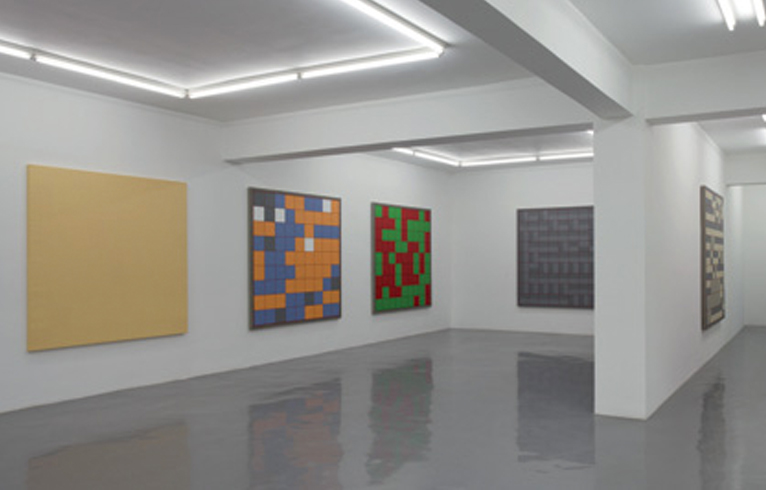ZHAN RUI: THE STOCK EXCHANGE, WEATHER, AND SEX
| October 21, 2011 | Post In LEAP 10

“The Stock Exchange, Weather and Sex” may sound borrowed from a Hollywood classic, but the implied drama and tension between these three disparate yet quotidian symbols finds scant response in the artist’s new collection of paintings. Instead, the audience encounters a series of color paintings made of lines and checkered patterns, their anticipation mercilessly flattened by Zhan’s seemingly cool and rationally obedient aesthetic formulations.
Perhaps the audience could learn something of dry humor from this kind of manipulation. However, the rhetorical undertone of this title is not motivated by logic, but rather by an attempt at the organic collation of three pillars of daily life. In one sense, such an attempt imbues Zhan Rui’s work with societal and humanistic sentiments that may act as an entry point to these oblique compositions; in another, it could actually hinder the ability to respond to his work analytically, to enter into dialogue with it using a single aesthetic vocabulary, a problem already magnified by the extreme minimalism that typifies much of Zhan’s creative output. Indeed, the eclecticism of this collection could be made up of residual elements of practices popular with the previous generation of contemporary Chinese artists.
But this ambiguity vis-à-vis the correct kind of value judgment appears to merely discomfit the fruits of Zhan Rui’s practice. Objectively speaking, Zhan the writer is actively attempting to rein in the painterliness of his practice, using square canvases to turn information drawn from quotidian life into a kind of visual, modular architecture. Changes in weather, the rise and fall of the stock market, or the relative activity of a person’s sex life take on symbols of a kind of primitive alphabet.
However, if the audience could be allowed access to Zhan Rui’s studio and witness the greater process of his creative practice, they would discover another subtle formal language at work. For in fact, subject matter aside, Zhan’s 9 x 9 grid system is designed to reflect his daily progress: each day he records the events of the day before; he interviews volunteers about their sex lives, asking them to choose representative colors, and the paintings unveil themselves over a period of eighty-one days. In other words, Zhan’s practice is less about efficacy, and rather more about a strict adherence to daily life, striving for a total naturalism.
His practice is defined by a taciturn patience, the ambient mushrooming of a theme amid apprehension and excitement. After completing 81 sections, in compliance with the Chinese colloquialism “nine and nine becomes one” (meaning “when all is said and done”), Zhan Rui then begins afresh. Due to the zealous, methodical nature of this creative process, one seemingly devoid of feeling, its result is paramount to a complete documentation of life experience. And so the core theme of this collection is temporally, rather than socially, inspired, the latter merely a phase, a spark that excites him into activity. Also worth considering is the delicacy and refinement of these paintings, particularly of the two “sex life” works, in which the initially conspicuous “temporal framework” has been reduced to dots embroidered within a modular grid, wherein the difference between two different levels of brightness of the same color is incredibly subtle. Admittedly, from the title May 1st 2010 to July 20th – Time for sex and love of 25 years old Miss A, the audience can essentially infer the source of the formal shifts within the painting. Though whether or not these shifts also signify a progression in Zhan himself? Well, he’s still only young. Sun Dongdong (Translated by Dominik Salter Dvorak)

